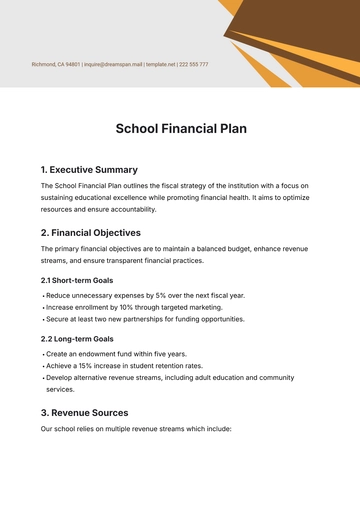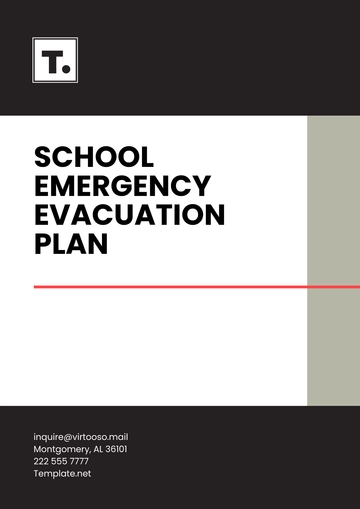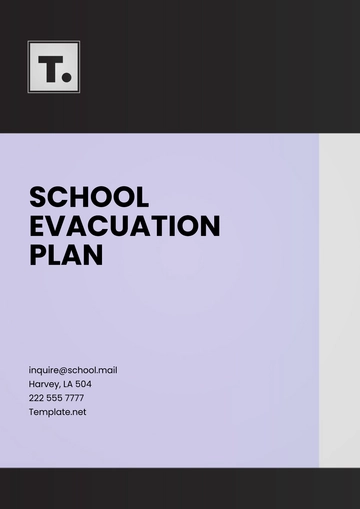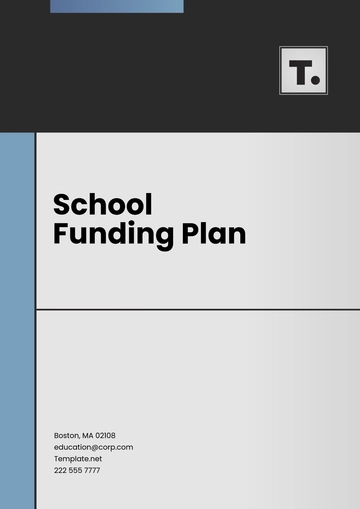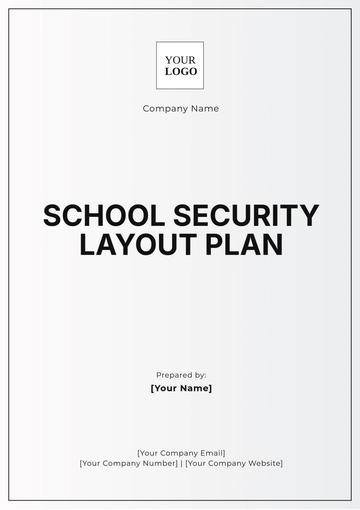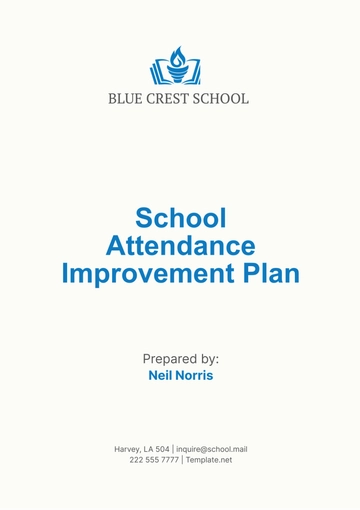Free School Attendance Improvement Plan
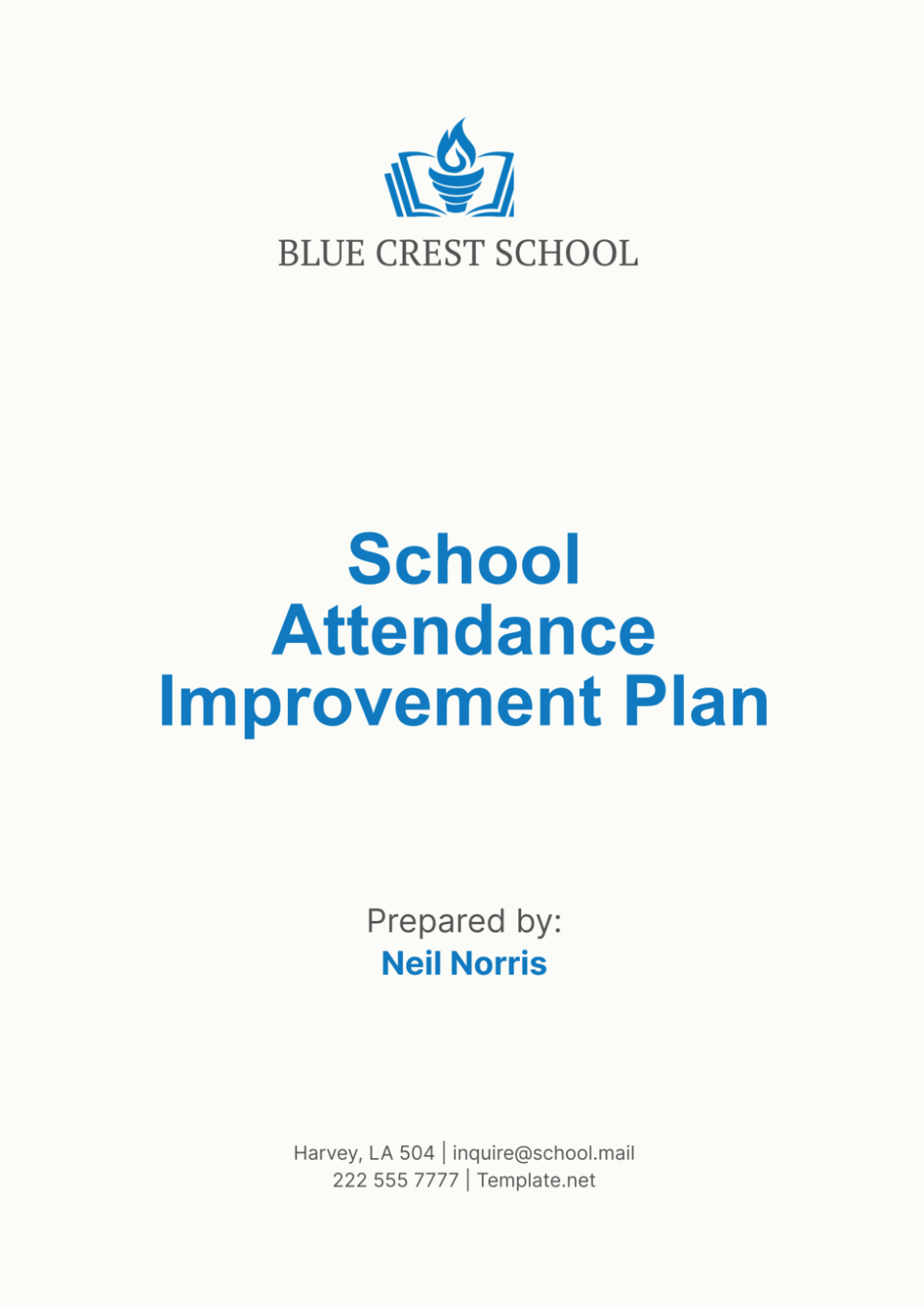
I. Overview
The School Attendance Improvement Plan for [Your Company Name] aims to address and improve student attendance rates, which are crucial for academic success and overall student well-being. Consistent attendance is directly linked to better performance, higher graduation rates, and a more positive school environment. This plan outlines comprehensive strategies and interventions to ensure that students attend school regularly, thereby enhancing their educational experience and future opportunities.
II. Introduction
Attendance is a fundamental aspect of a student's education. At [Your Company Name], we have observed that attendance rates have a significant impact on student achievement and engagement. This plan is designed to systematically address the factors contributing to absenteeism and provide structured support to students and families. Our objectives are to identify attendance issues early, implement effective strategies to encourage regular attendance, and create a supportive school culture that values and promotes daily school attendance.
III. Analysis of Current Attendance Data
To develop a targeted and effective Attendance Improvement Plan, it is essential to analyze the current attendance data comprehensively. This analysis includes a detailed review of attendance records over the past three years, identifying patterns and trends that highlight periods of high absenteeism, and determining which student groups are most affected.
The table below summarizes the attendance rates for the past three academic years at [Your Company Name]:
Academic Year | Attendance Rate (%) | Chronic Absenteeism (%) |
|---|---|---|
[20xx-20xx] | 89% | 12% |
[20xx-20xx] | 87% | 15% |
[20xx-20xx] | 85% | 18% |
From the data, it is evident that there has been a decline in overall attendance rates and an increase in chronic absenteeism. These trends necessitate immediate and effective interventions. Additionally, comparing our school’s data with district and state averages provides a clearer perspective on where we stand and what benchmarks we need to meet.
IV. Goals and Objectives
The primary goal of this plan is to improve overall attendance rates at [Your Company Name] by reducing chronic absenteeism and promoting a culture of regular attendance. The following are our specific, measurable goals:
Increase the overall attendance rate to 92% by the end of the next academic year.
Reduce the percentage of chronically absent students by 50% within two years.
Ensure that no student group has an attendance rate lower than 90%.
To achieve these goals, our objectives include implementing a multi-tiered approach to address the diverse reasons for absenteeism, from preventive measures to intensive interventions for those with significant attendance issues.
V. Strategies for Improvement
A. Prevention Strategies
Creating a Positive School Environment:
At [Your Company Name], fostering a welcoming and inclusive school environment is a top priority. A positive atmosphere encourages students to attend school regularly. We will achieve this by:
Implementing social-emotional learning programs to build a supportive community.
Enhancing school facilities and creating safe, engaging spaces for students.
Encouraging student participation in extracurricular activities that make school a place they want to be.
Implementing Engaging Curriculum and Activities:
An engaging and relevant curriculum motivates students to attend classes regularly. We will work on:
Incorporating project-based learning and hands-on activities that make learning exciting.
Offering a variety of elective courses that cater to diverse interests and talents.
Ensuring that all lessons are culturally responsive and inclusive.
Promoting the Importance of Attendance:
Raising awareness about the importance of attendance among students and parents is critical. Our strategies include:
Organizing regular workshops and information sessions for parents and students.
Creating attendance awareness campaigns using posters, newsletters, and social media.
Recognizing and rewarding good attendance through certificates, assemblies, and other incentives.
B. Early Intervention Strategies
Identifying At-Risk Students:
Early identification of students who are at risk of chronic absenteeism allows for timely interventions. We will:
Use data from attendance records to identify students with patterns of absenteeism.
Employ a team of counselors and social workers to assess the underlying causes of absenteeism.
Develop a system for teachers to report concerns about student attendance early.
Providing Support and Resources:
Supporting at-risk students and their families is crucial. Our approach includes:
Offering counseling services to address personal and family issues impacting attendance.
Providing academic support through tutoring and mentoring programs.
Establishing a resource center where families can access community services such as healthcare, housing assistance, and transportation.
Utilizing Attendance Monitoring Systems:
Implementing advanced attendance monitoring systems helps track and manage attendance more effectively. We plan to:
Adopt electronic attendance tracking tools that provide real-time data.
Set up automated notifications to alert parents about absences promptly.
Regularly review attendance data to identify trends and areas needing attention.
C. Intensive Intervention Strategies
Developing Personalized Attendance Improvement Plans:
For students with chronic absenteeism, personalized plans are essential. These plans will:
Include detailed assessments of each student's situation, involving input from parents, teachers, and counselors.
Outline specific steps and support systems tailored to the student's needs.
Set clear attendance goals and regular progress reviews.
Collaborating with Community Organizations:
Community support is vital in addressing attendance issues. We will:
Partner with local organizations that provide services such as mental health counseling, legal aid, and family support.
Involve community mentors to work with students and provide additional guidance and encouragement.
Coordinate with local health services to address health-related absenteeism.
Enforcing Attendance Policies and Legal Requirements:
Ensuring compliance with attendance policies is crucial. Our approach includes:
Clearly communicating attendance policies to students and parents at the start of the school year.
Implementing a consistent process for addressing unexcused absences, including parent meetings and warning letters.
Collaborating with local authorities when legal action is necessary for habitual truancy.
VI. Roles and Responsibilities
Effective implementation of the Attendance Improvement Plan requires the commitment and collaboration of all stakeholders. At [Your Company Name], we have defined the following roles and responsibilities:
A. School Administration
The school administration, including the principal and assistant principals, will lead the implementation of the plan. Their responsibilities include:
Overseeing the collection and analysis of attendance data.
Ensuring that all strategies and interventions are implemented effectively.
Communicating progress and challenges to the school community and making adjustments as needed.
B. Teachers
Teachers play a crucial role in promoting regular attendance and engaging students. Their responsibilities include:
Creating a welcoming and inclusive classroom environment that encourages attendance.
Monitoring student attendance and identifying early signs of absenteeism.
Providing additional support to students who are struggling with attendance issues.
C. Parents and Guardians
Parents and guardians are key partners in ensuring regular school attendance. Their responsibilities include:
Ensuring that their children attend school daily and on time.
Communicating with the school about any attendance issues or concerns.
Supporting their children’s education by being involved in school activities and staying informed about their progress.
D. Community Partners
Community partners, including local organizations and businesses, can provide valuable support to students and families. Their responsibilities include:
Offering resources and services that address the underlying causes of absenteeism, such as health care, legal aid, and family support.
Collaborating with the school to develop and implement community-based interventions.
Supporting school initiatives through funding, volunteer efforts, and advocacy.
By clearly defining these roles and responsibilities, [Your Company Name] aims to create a collaborative and supportive network that promotes regular attendance and academic success.
VII. Communication Plan
Effective communication is key to the successful implementation of the School Attendance Improvement Plan at [Your Company Name]. Clear, consistent, and comprehensive communication ensures that all stakeholders are informed, engaged, and committed to improving attendance rates.
A. Communication Strategies
Students:
Classroom Announcements: Teachers will regularly remind students of the importance of attendance and recognize those with excellent attendance records.
School Assemblies: Attendance awards and recognitions will be presented during school assemblies to highlight the significance of regular attendance.
Student Council: Involvement of student council members in promoting attendance initiatives and serving as attendance ambassadors.
Parents:
Parent-Teacher Meetings: Regular meetings to discuss their child's attendance and strategies to improve it.
Newsletters: Monthly newsletters will include articles on the importance of attendance, success stories, and tips for ensuring students attend school regularly.
Automated Alerts: Use of automated phone calls, texts, and emails to notify parents of their child’s absences in real-time.
Staff:
Staff Meetings: Regular updates on attendance data, goals, and progress during staff meetings.
Professional Development Workshops: Training sessions focused on attendance policies, intervention strategies, and best practices.
Internal Memos and Emails: Regular communications to keep staff informed and involved in attendance initiatives.
B. Reporting Attendance Data
A transparent system for reporting attendance data is essential. The following table outlines the methods and frequency of reporting attendance data:
Stakeholder | Method of Communication | Frequency |
|---|---|---|
Students | Classroom Announcements | Weekly |
Parents | Newsletters | Monthly |
Parents | Automated Alerts | As needed |
Staff | Staff Meetings | Bi-weekly |
School Board | Attendance Reports | Quarterly |
VIII. Professional Development
Providing staff with the necessary training and resources is crucial for the success of the Attendance Improvement Plan at [Your Company Name]. Professional development ensures that teachers, administrators, and support staff are equipped to address attendance issues effectively.
A. Training Programs
Understanding Attendance Policies:
Comprehensive training on school attendance policies, legal requirements, and the consequences of absenteeism.
Workshops on how to communicate attendance policies to students and parents.
Intervention Strategies:
Sessions on identifying at-risk students and implementing early intervention strategies.
Training on developing personalized attendance improvement plans for chronically absent students.
Engaging Students:
Workshops on creating an engaging and inclusive classroom environment.
Techniques for integrating social-emotional learning into the curriculum to enhance student engagement.
Use of Technology:
Training on using attendance monitoring systems and data analysis tools.
How to effectively communicate with parents using automated systems.
Professional Development Schedule:
Training Program | Target Audience | Schedule |
|---|---|---|
Understanding Attendance Policies | All Staff | Beginning of Year |
Intervention Strategies | Teachers, Counselors | Quarterly |
Engaging Students | Teachers | Monthly |
Use of Technology | Administrative Staff | Bi-annual |
IX. Monitoring and Evaluation
Continuous monitoring and evaluation of the Attendance Improvement Plan are vital to ensure its effectiveness and make necessary adjustments. At [Your Company Name], a systematic approach to monitoring and evaluation will be employed.
A. Monitoring Attendance Data
Daily Monitoring:
Teachers will take attendance daily and input data into the electronic attendance system.
Administrative staff will review daily attendance records to identify any immediate concerns.
Weekly Reviews:
The attendance team will review weekly attendance data to identify trends and at-risk students.
Meetings with teachers to discuss any emerging issues and plan interventions.
Monthly Reports:
Detailed monthly reports on attendance data, including comparisons to previous months and identification of chronic absenteeism cases.
Presentation of these reports to school leadership for review and action planning.
B. Evaluation Methods
Progress Assessment:
Quarterly assessment of progress towards the set attendance goals.
Comparison of attendance rates to district and state averages to measure improvement.
Feedback Collection:
Surveys of students, parents, and staff to gather feedback on the effectiveness of attendance strategies and interventions.
Focus groups with at-risk students and their families to understand barriers to attendance and refine support measures.
Adjustments to the Plan:
Based on the monitoring data and feedback, adjustments to the Attendance Improvement Plan will be made as needed.
Continuous cycle of assessment, feedback, and adjustment to ensure ongoing improvement.
X. Budget and Resources
A detailed budget is essential for the successful implementation of the Attendance Improvement Plan. This includes funding for professional development, technology, rewards and incentives, and support services for students and families.
A. Budget Allocation
Professional Development:
Workshops and training sessions for staff on attendance policies and intervention strategies.
Budget: $10,000 annually.
Technology:
Purchase and maintenance of attendance monitoring systems and software.
Budget: $15,000 annually.
Rewards and Incentives:
Certificates, awards, and other incentives for students with excellent attendance.
Budget: $5,000 annually.
Support Services:
Counseling services, academic support programs, and resources for families in need.
Budget: $20,000 annually.
Resource Allocation:
Category | Budget Allocation ($) | Description |
|---|---|---|
Professional Development | 10,000 | Training sessions and workshops for staff |
Technology | 15,000 | Attendance monitoring systems and software |
Rewards and Incentives | 5,000 | Awards and certificates for students |
Support Services | 20,000 | Counseling and academic support for students |
XI. Conclusion
The School Attendance Improvement Plan for [Your Company Name] is a comprehensive approach to enhancing student attendance through targeted strategies, effective communication, professional development, continuous monitoring, and adequate resource allocation. By addressing the underlying causes of absenteeism and fostering a supportive school environment, we aim to improve attendance rates and ensure that all students have the opportunity to succeed academically.
This plan requires the collaboration and commitment of all stakeholders, including students, parents, staff, and community partners. Together, we can create a culture of regular attendance and academic excellence at [Your Company Name].
- 100% Customizable, free editor
- Access 1 Million+ Templates, photo’s & graphics
- Download or share as a template
- Click and replace photos, graphics, text, backgrounds
- Resize, crop, AI write & more
- Access advanced editor
Enhance attendance rates with Template.net's School Attendance Improvement Plan Template. Customizable and editable via the Ai Editor Tool, this template helps schools develop effective improvement plans. Personalize it to include specific strategies and goals. Ensure professional and organized attendance improvement initiatives for your school.
You may also like
- Finance Plan
- Construction Plan
- Sales Plan
- Development Plan
- Career Plan
- Budget Plan
- HR Plan
- Education Plan
- Transition Plan
- Work Plan
- Training Plan
- Communication Plan
- Operation Plan
- Health And Safety Plan
- Strategy Plan
- Professional Development Plan
- Advertising Plan
- Risk Management Plan
- Restaurant Plan
- School Plan
- Nursing Home Patient Care Plan
- Nursing Care Plan
- Plan Event
- Startup Plan
- Social Media Plan
- Staffing Plan
- Annual Plan
- Content Plan
- Payment Plan
- Implementation Plan
- Hotel Plan
- Workout Plan
- Accounting Plan
- Campaign Plan
- Essay Plan
- 30 60 90 Day Plan
- Research Plan
- Recruitment Plan
- 90 Day Plan
- Quarterly Plan
- Emergency Plan
- 5 Year Plan
- Gym Plan
- Personal Plan
- IT and Software Plan
- Treatment Plan
- Real Estate Plan
- Law Firm Plan
- Healthcare Plan
- Improvement Plan
- Media Plan
- 5 Year Business Plan
- Learning Plan
- Marketing Campaign Plan
- Travel Agency Plan
- Cleaning Services Plan
- Interior Design Plan
- Performance Plan
- PR Plan
- Birth Plan
- Life Plan
- SEO Plan
- Disaster Recovery Plan
- Continuity Plan
- Launch Plan
- Legal Plan
- Behavior Plan
- Performance Improvement Plan
- Salon Plan
- Security Plan
- Security Management Plan
- Employee Development Plan
- Quality Plan
- Service Improvement Plan
- Growth Plan
- Incident Response Plan
- Basketball Plan
- Emergency Action Plan
- Product Launch Plan
- Spa Plan
- Employee Training Plan
- Data Analysis Plan
- Employee Action Plan
- Territory Plan
- Audit Plan
- Classroom Plan
- Activity Plan
- Parenting Plan
- Care Plan
- Project Execution Plan
- Exercise Plan
- Internship Plan
- Software Development Plan
- Continuous Improvement Plan
- Leave Plan
- 90 Day Sales Plan
- Advertising Agency Plan
- Employee Transition Plan
- Smart Action Plan
- Workplace Safety Plan
- Behavior Change Plan
- Contingency Plan
- Continuity of Operations Plan
- Health Plan
- Quality Control Plan
- Self Plan
- Sports Development Plan
- Change Management Plan
- Ecommerce Plan
- Personal Financial Plan
- Process Improvement Plan
- 30-60-90 Day Sales Plan
- Crisis Management Plan
- Engagement Plan
- Execution Plan
- Pandemic Plan
- Quality Assurance Plan
- Service Continuity Plan
- Agile Project Plan
- Fundraising Plan
- Job Transition Plan
- Asset Maintenance Plan
- Maintenance Plan
- Software Test Plan
- Staff Training and Development Plan
- 3 Year Plan
- Brand Activation Plan
- Release Plan
- Resource Plan
- Risk Mitigation Plan
- Teacher Plan
- 30 60 90 Day Plan for New Manager
- Food Safety Plan
- Food Truck Plan
- Hiring Plan
- Quality Management Plan
- Wellness Plan
- Behavior Intervention Plan
- Bonus Plan
- Investment Plan
- Maternity Leave Plan
- Pandemic Response Plan
- Succession Planning
- Coaching Plan
- Configuration Management Plan
- Remote Work Plan
- Self Care Plan
- Teaching Plan
- 100-Day Plan
- HACCP Plan
- Student Plan
- Sustainability Plan
- 30 60 90 Day Plan for Interview
- Access Plan
- Site Specific Safety Plan
